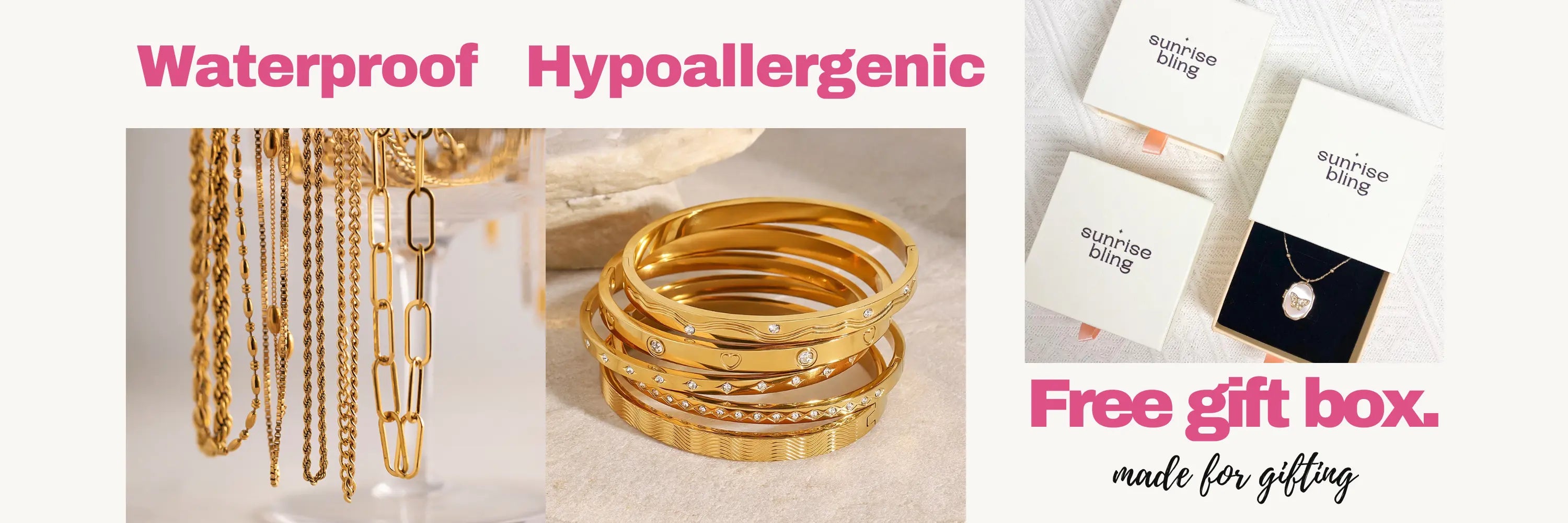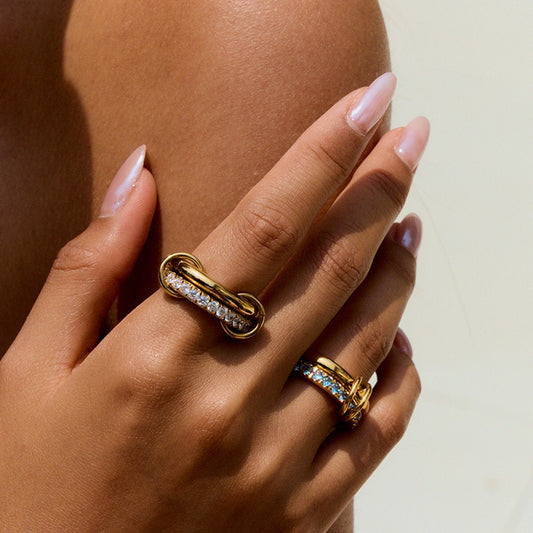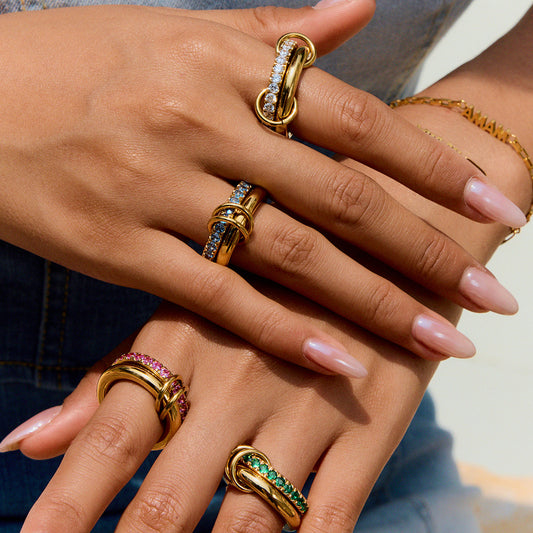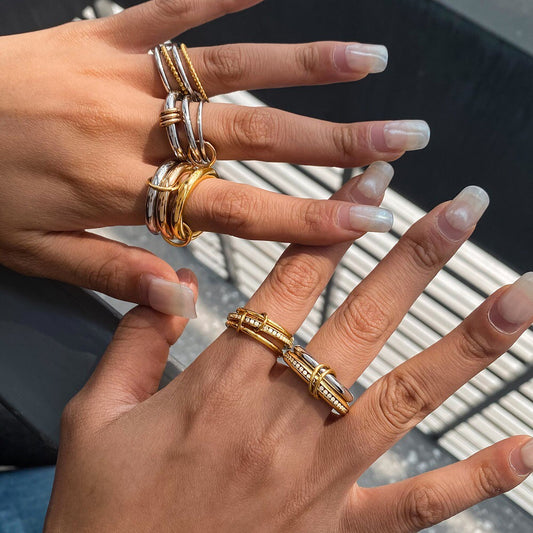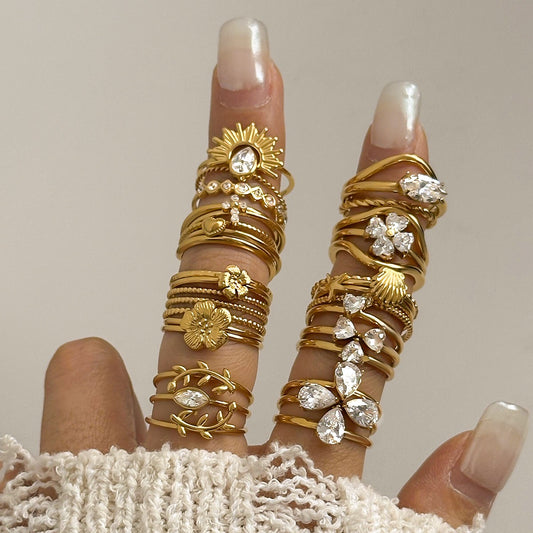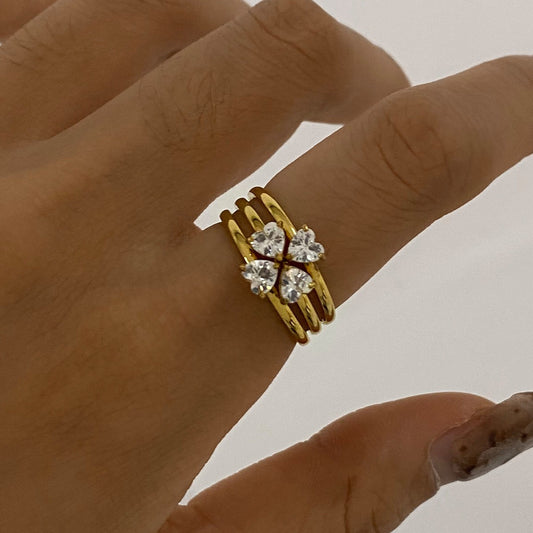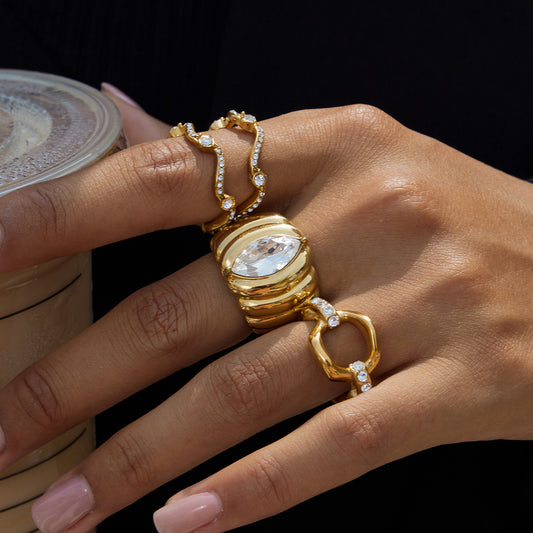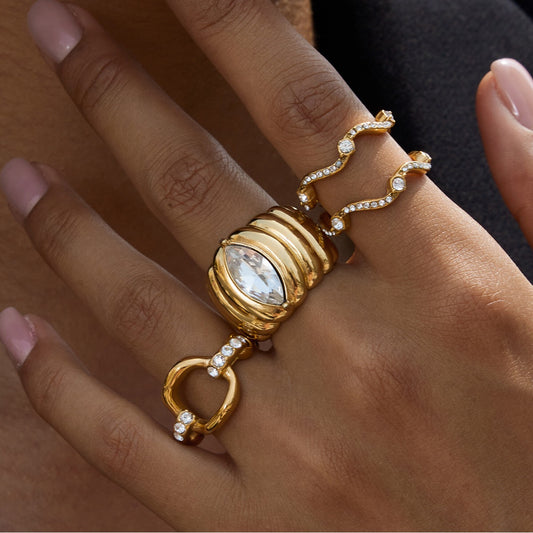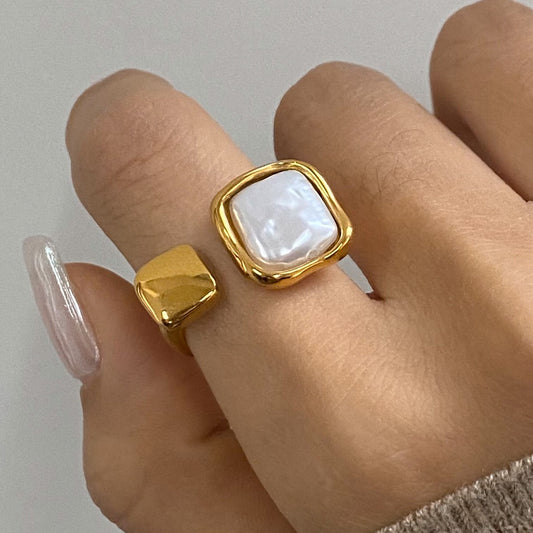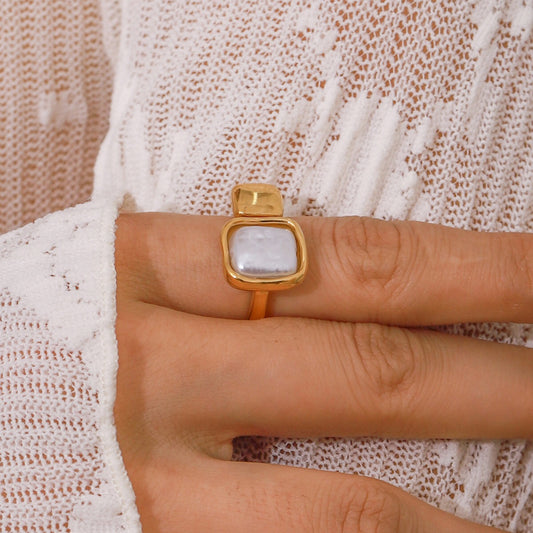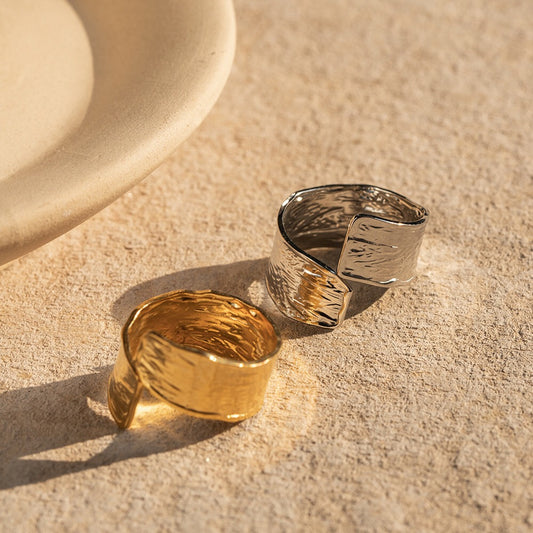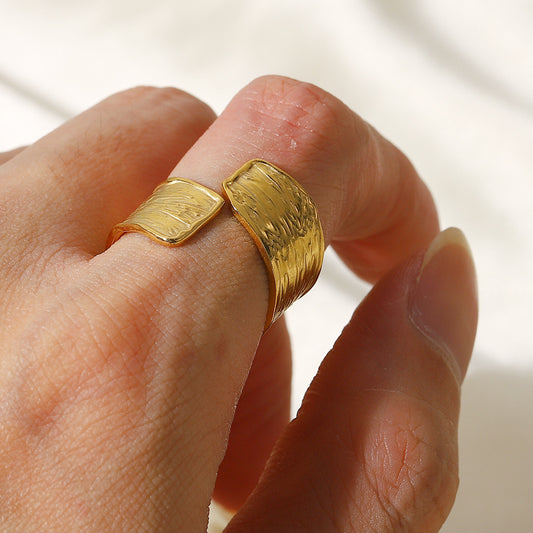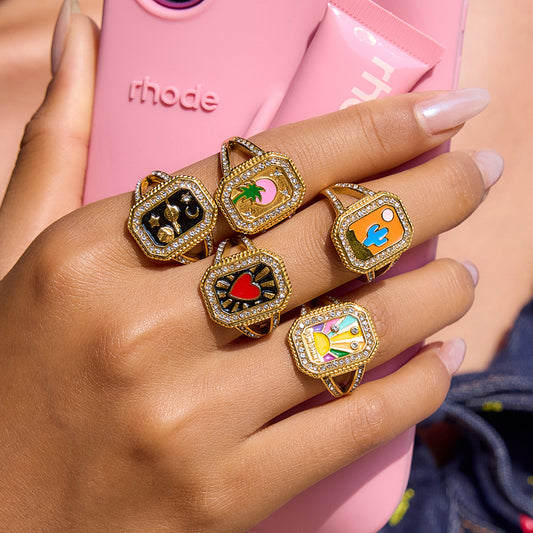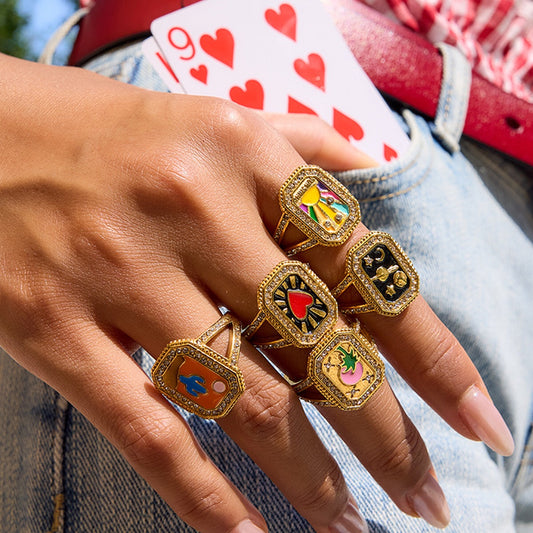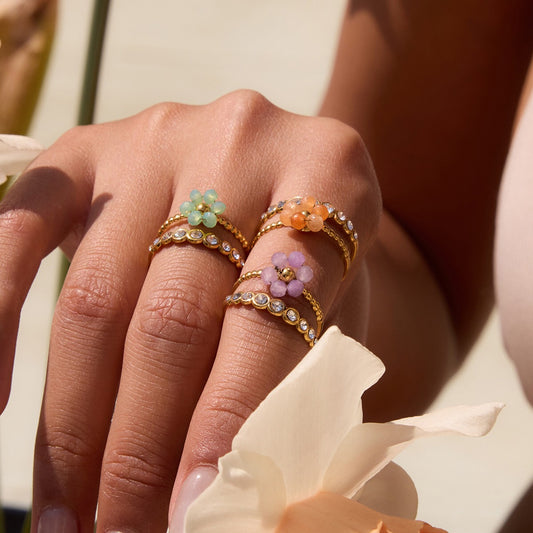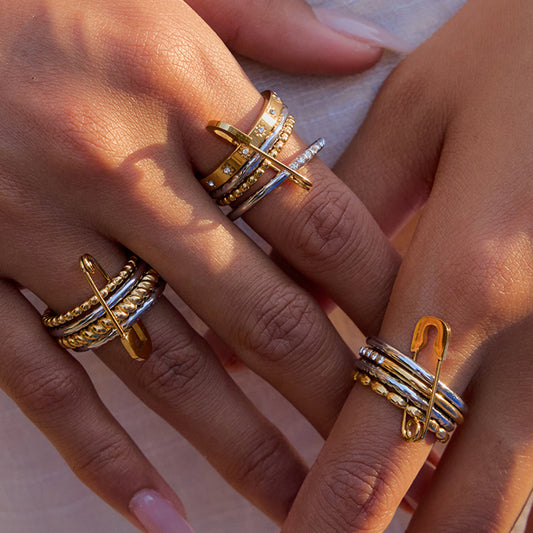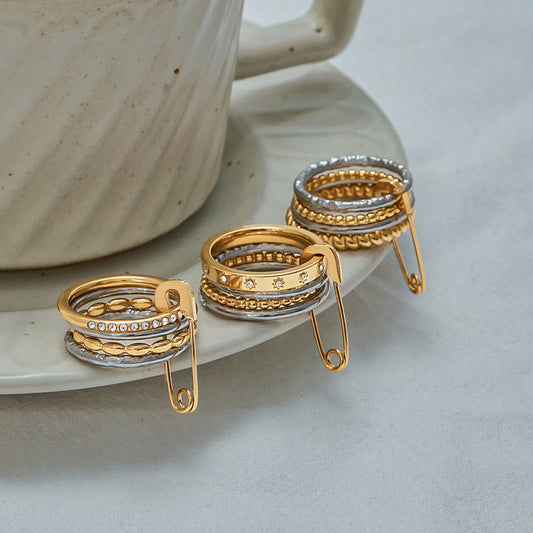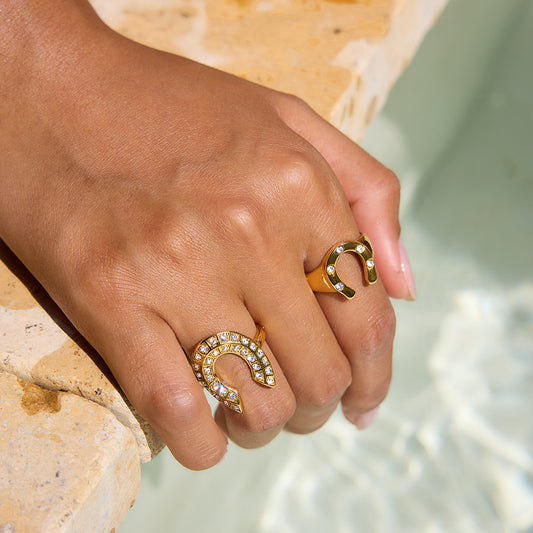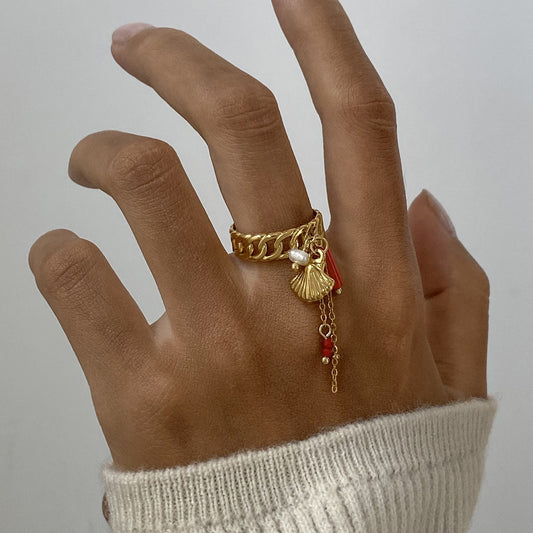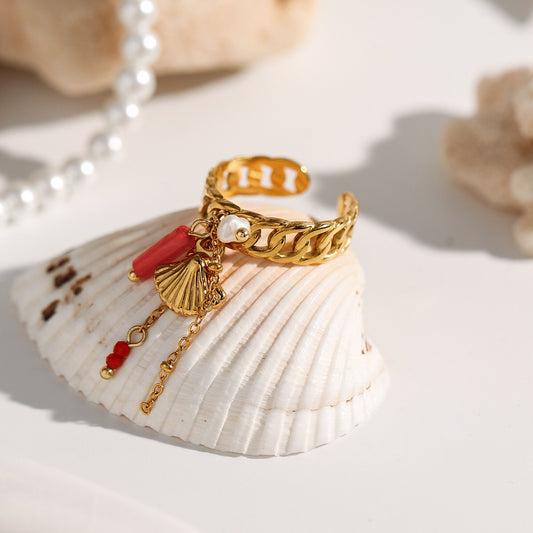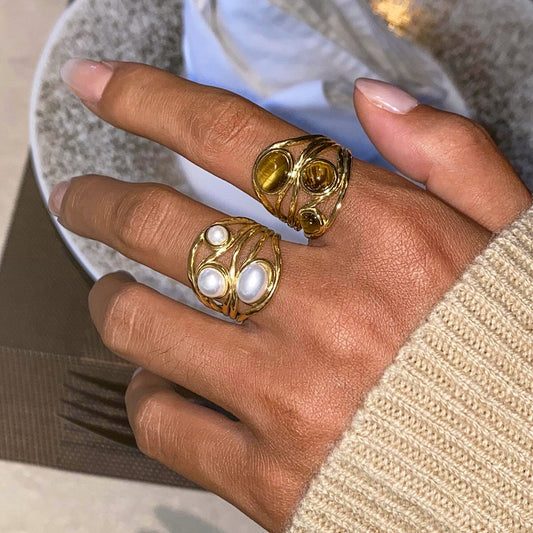How to find your ring size is one of the most common questions for anyone buying a ring—whether it’s a gold wedding band for your partner, a birthstone ring for yourself, or a promise ring for your girlfriend. And for good reason: getting the size wrong leads to frustration, returns, or worse—an unworn ring collecting dust. The global jewelry market size was estimated at USD 366.79 billion in 2024 and is projected to reach USD 578.45 billion by 2033, growing at a CAGR of 5.3%. The good news? Finding your ring size doesn’t require a trip to the jeweler—with a few household items or simple tools, you can get an accurate measurement in minutes. This guide walks you through everything you need to know: from what ring size means to step-by-step methods for measuring, plus tips for gifting and caring for your ring.

What Is Ring Size?
Ring size is a standardized measurement used to determine how well a ring fits on a finger—ensuring it’s not too tight (which can cut off circulation) or too loose (which risks falling off). Sizing systems vary by region, but the most common in North America is the numerical system, where sizes range from 3 (smallest) to 13 (largest) for adults, with half-sizes (e.g., 6.5, 7.5) for a more precise fit.
Understanding ring size starts with knowing how it’s measured: the size corresponds to the inner circumference of the ring (the distance around the inside of the band) or the inner diameter (the distance across the inside of the band). For example, a size 7 ring has an inner circumference of 62.2mm and an inner diameter of 19.8mm.
Key Details About Ring Sizing Systems
-
North American (Numerical) System: The most widely used system in the U.S. and Canada—sizes 3–13 for adults, with half-sizes. Women’s average ring size is 6–7; men’s average is 9–10.
-
European (Millimeter) System: Uses the inner circumference in millimeters (mm) directly—e.g., a ring with a 54mm circumference is a European size 54 (equivalent to a North American size 6).
-
UK/Australian (Alphabetical) System: Uses letters A–Z (A = smallest, Z = largest)—e.g., a UK size L is equivalent to a North American size 6.
-
Children’s Sizes: Typically range from 1–4 (North American) or 34–44mm (European), with adjustable bands for growing fingers.
Factors That Affect Ring Size
-
Finger Temperature: Fingers swell in warm weather or after exercise (increasing size by 0.5–1 full size) and shrink in cold weather (decreasing size). Measure your finger when it’s at a normal temperature (e.g., indoors, not right after a workout or shower).
-
Finger Shape: Some fingers are straight, while others taper (wider at the base, narrower at the knuckle) or are wider at the knuckle. For tapered fingers, choose a size that fits the base snugly; for wider knuckles, ensure the ring can slide over the knuckle without being too loose on the base.
-
Time of Day: Fingers are slightly larger in the afternoon and evening than in the morning. Measure your finger in the evening for the most accurate fit.

How to Find Your Ring Size
Finding your ring size is simple—you can use household items, a printable ring sizer, or a jeweler’s tool. Below are the most accurate methods, ordered by ease and accessibility:
Method 1: Use a Printable Ring Sizer (Most Accurate at Home)
Printable ring sizers are free, easy to use, and widely available online (from retailers like Blue Nile, Zales, or Kay Jewelers). Here’s how to use one:
-
Print the Sizer: Download a printable ring sizer PDF and print it at 100% scale (do not “fit to page”—this will distort the size).
-
Verify the Scale: Check the “test line” on the sizer (usually a 20mm or 1-inch line) with a ruler to ensure it’s accurate. If the test line is too short or long, reprint the PDF.
-
Cut the Sizer: Cut out the sizer strip, which has a slit at one end and size markings along the length.
-
Measure Your Finger: Slide the pointed end of the sizer through the slit to form a loop. Place the loop around the finger you want to measure, pulling it snug (but not tight) against the base of the finger.
-
Read the Size: The number or letter aligned with the slit is your ring size. For extra accuracy, measure 2–3 times and take the average.
Method 2: Use a String or Paper Strip (Household Item Method)
If you don’t have a printer, you can use a piece of string, floss, or a thin paper strip. Here’s how:
-
Prepare the Material: Cut a 6-inch piece of string or paper (thinner is better—thick paper may add extra bulk and skew the measurement).
-
Wrap Around Your Finger: Wrap the string/paper around the base of the finger you want to measure, ensuring it’s snug but not tight (you should be able to slide one finger under the material).
-
Mark the Spot: Use a pen or pencil to mark where the end of the string/paper overlaps with the rest of the strip.
-
Measure the Length: Lay the string/paper flat and use a ruler to measure the distance from the start to the marked spot (this is the inner circumference of your ring).
-
Convert to Size: Use a ring size chart (available online) to convert the circumference to your North American, European, or UK size. For example:
-
60mm circumference = North American size 6.5
-
62mm circumference = North American size 7

Method 3: Use an Existing Ring (Best for Gifting)
If you’re buying a ring for someone else and don’t want to spoil the surprise, use one of their existing rings (that fits the same finger you’re buying for) to measure:
-
Measure the Inner Diameter: Place the ring on a ruler and measure the distance across the inside of the band (from one edge to the opposite edge). Avoid measuring the outer diameter—this will be too large.
-
Convert to Size: Use a ring size chart to convert the diameter to a ring size. For example:
-
19.8mm diameter = North American size 7
-
20.6mm diameter = North American size 8
-
Double-Check: If the ring is wide (6mm+), add a half-size to the measurement—wider bands fit more snugly than thin bands.
Method 4: Visit a Jeweler (Most Accurate Overall)
For the most precise measurement (especially for expensive rings like gold wedding bands or engagement rings), visit a local jeweler. Here’s what to expect:
-
Professional Tools: Jewelers use a ring mandrel (a metal rod marked with sizes) or a digital sizer to measure your finger.
-
Expert Advice: They’ll account for factors like finger shape, knuckle width, and band width to recommend the perfect size.
-
Free Service: Most jewelers offer ring sizing for free, even if you don’t buy the ring from them.
Why Is Ring (Jewelry) So Popular?
Rings are one of the oldest and most popular forms of jewelry—used for thousands of years to symbolize love, status, faith, or achievement. Their enduring popularity stems from their versatility, symbolism, and ability to fit every style and budget.
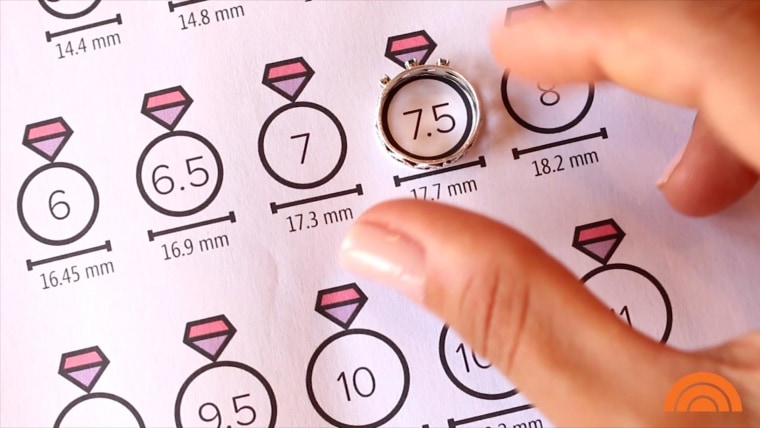
Symbolism That Resonates Across Cultures
Rings are more than just accessories—they carry deep meaning:
-
Love & Commitment: Engagement rings and wedding bands symbolize lifelong love (e.g., a gold wedding band’s circular shape represents “forever”).
-
Status & Achievement: Class rings, championship rings, or academic rings mark important milestones and signal accomplishment.
-
Faith & Identity: Religious rings (e.g., cross rings, Star of David rings) express faith, while family crest rings honor heritage.
Versatility for Every Occasion
Rings work for every moment—from casual days to formal events:
-
Everyday Wear: Thin gold or silver bands, birthstone rings, or minimalist studs are durable enough for cooking, working, or exercising.
-
Special Occasions: Diamond rings, gemstone-encrusted bands, or vintage-inspired designs add glamour to weddings, parties, or holidays.
-
Layering: Stacking thin rings (e.g., a gold band + a birthstone ring + a delicate chain ring) is a trendy way to express personal style.
Accessibility for Every Budget
Rings are available at every price point, making them accessible to everyone:
-
Affordable: Costume jewelry rings (plastic, brass, or gold-plated) cost \(5–\)50—great for trends or teens.
-
Mid-Range: Sterling silver, 14k gold-filled, or semi-precious gemstone rings cost \(50–\)500—everyday luxury for most shoppers.
-
Luxury: Solid gold, diamond, or designer rings cost \(500–\)10,000+—heirloom pieces for milestones like engagements or anniversaries.
Popular Styles of Rings
Rings come in endless styles, from minimalist to bold, ensuring there’s a design for every taste. Below are the most in-demand options:

Minimalist Rings (Everyday Essential)
These styles prioritize simplicity and versatility—perfect for daily wear or stacking:
-
Plain Metal Bands: Thin or medium-width bands in gold, silver, or rose gold (e.g., a 14k gold plain band). Smooth and understated, they complement any outfit.
-
Stackable Rings: Tiny, delicate bands (often with subtle textures like hammered or twisted details) designed to be worn together. Mix metals or add a single gemstone ring for interest.
-
Midi Rings: Worn above the knuckle (on the middle phalanx of the finger), these small rings add a trendy, delicate touch—great for layering with traditional rings.
Gemstone Rings (Color & Sparkle)
Gemstone rings add color and meaning, making them popular for gifting or personal style:
-
Birthstone Rings: A single birthstone (e.g., garnet for January, amethyst for February) set in a simple band. Personal and meaningful, ideal for birthdays or holidays.
-
Diamond Rings: Solitaire diamond rings (one large diamond), three-stone diamond rings (symbolizing past, present, future), or diamond accent rings (small diamonds around a band). Timeless and luxurious.
-
Colored Gemstone Rings: Bold gemstones like sapphires, rubies, or emeralds set in gold or silver. Perfect for adding a pop of color to casual or formal outfits.
Vintage-Inspired Rings (Retro Charm)
These styles draw inspiration from past eras, perfect for lovers of classic design:
-
Art Deco Rings: Geometric shapes, filigree details, and bold gemstones (popular in the 1920s–1930s). Often feature white gold or platinum with diamonds or sapphires.
-
Victorian Rings: Intricate engravings, pearl accents, and rose gold (popular in the 1830s–1900s). Romantic and ornate, ideal for formal events.
-
Mid-Century Rings: Simple, sleek designs with large gemstones (popular in the 1940s–1960s). Often made with yellow gold and emeralds or rubies.
Statement Rings (Bold & Unique)
For those who want to stand out, statement rings feature eye-catching designs or large details:
-
Cocktail Rings: Large, bold rings with oversized gemstones (real or simulated) or unique shapes (e.g., flowers, animals). Worn on the middle or index finger for maximum impact.
-
Signet Rings: Flat, rectangular or oval rings with a personalized engraving (e.g., initials, a family crest). Traditionally worn by men but now popular for women too.
-
Bypass Rings: Rings that “bypass” each other (two bands that cross at the top) with a gemstone or detail in the center. Modern and edgy, perfect for fashion-forward styles.
How to Wear Rings
Wearing rings is a fun way to express your style—whether you prefer a minimalist look or a stacked, bold ensemble. Below are tips for different looks and occasions:
Styling for Casual Everyday Wear
-
Solo Minimalist Ring: A thin gold or silver band on the ring finger or middle finger pairs with jeans, a t-shirt, and sneakers. Keep other jewelry simple (small stud earrings, a thin necklace) to let the ring shine.
-
Stacked Thin Rings: Layer 2–3 stackable rings (mix of metals or textures) on one finger—e.g., a hammered silver band + a tiny gold band + a birthstone ring. Adds texture without feeling cluttered.
-
Midi Ring + Traditional Ring: Wear a midi ring on the middle finger (above the knuckle) and a plain band on the same finger’s base. Trendy and effortless, perfect for coffee runs or errands.
Styling for Work or Professional Settings
-
Single Gemstone Ring: A small birthstone or diamond accent ring on the ring finger complements a blazer, button-down shirt, and tailored trousers. It’s subtle enough for meetings but adds a personal touch.
-
Minimalist Stack: 1–2 thin metal bands (same metal, e.g., all gold) on the middle finger. Professional and polished, ideal for office environments that prefer understated jewelry.
-
Signet Ring: A simple signet ring with initials on the index finger. Classic and authoritative, perfect for leadership roles or client-facing jobs.
Styling for Formal Occasions
-
Statement Cocktail Ring: A large cocktail ring on the middle finger pairs with a floor-length gown or cocktail dress. Skip other hand jewelry—let the ring be the focal point.
-
Vintage-Inspired Gemstone Ring: An Art Deco or Victorian ring with diamonds or sapphires complements a formal gown. Adds elegance and retro charm to black-tie events.
-
Diamond Stack: Layer 2–3 diamond accent rings (same metal) on one finger—e.g., a thin diamond band + a plain gold band + another thin diamond band. Sparkly and sophisticated, perfect for weddings or galas.
Styling Tips for Different Hand Sizes
-
Small Hands/Fingers: Opt for thin or medium-width rings (2–4mm) with small gemstones. Avoid oversized statement rings—they can overwhelm small hands.
-
Medium Hands/Fingers: Most ring styles work—balance thin and thick bands, or stack 2–3 rings for interest. Medium-sized gemstones (0.5–1ct) are ideal.
-
Large Hands/Fingers: Choose wider bands (5mm+) or bold statement rings. Larger gemstones (1ct+) or geometric shapes complement larger hands without feeling disproportionate.
Ring: Perfect Gift for Your Girlfriend
A ring is a thoughtful, meaningful gift for your girlfriend—it shows you’ve paid attention to her style and want to give her something she’ll wear and cherish. Unlike flowers or chocolates, a ring is a lasting reminder of your love, perfect for birthdays, anniversaries, or “just because” moments.
Why It Resonates as a Girlfriend Gift
-
Personalization: You can choose a ring that reflects her personality—minimalist if she’s low-key, birthstone if you want to add sentiment, or gemstone if she loves sparkle.
-
Versatility: She’ll wear it with nearly every outfit, from casual to formal—unlike a dress or bag that’s only used occasionally.
-
Symbolism: A ring can symbolize your commitment (e.g., a promise ring) or your appreciation (e.g., a birthstone ring to honor her). It’s a gift that says, “I see you.”
Top Ring Gifts for Your Girlfriend
-
Birthstone Ring: A small birthstone set in a 14k gold or silver band. Engrave the inside with a meaningful date (e.g., your first date) for an extra personal touch.
-
Minimalist Gold Band: A thin 14k gold plain band or stackable band. Perfect for everyday wear and easy to pair with other jewelry she owns.
-
Diamond Accent Ring: A tiny diamond set in a delicate band. Subtle enough for daily wear but sparkly enough to feel special—ideal for anniversaries.
Tips for Choosing the Right Ring
-
Know Her Style: Notice if she wears delicate or bold jewelry—opt for thin bands and small gemstones if she’s minimalist, or a statement ring if she loves to stand out. Check her existing jewelry to see if she prefers gold, silver, or rose gold.
-
Get the Size Right: Use the “existing ring method” (measure one of her rings) or ask her friend for help. If you’re unsure, choose an adjustable ring or a style that can be resized (most jewelers offer free resizing within 30 days).
-
Consider Her Lifestyle: If she’s active (works out, gardens), choose a durable metal (14k gold, sterling silver) and a smooth band (no sharp edges to catch on clothing). If she works in an office, a gemstone or engraved ring is perfect.
How to Clean Rings
Regular cleaning keeps your rings looking shiny and prevents buildup of dirt, lotion, and oils—especially important for rings worn daily. The cleaning process varies by the ring’s material and whether it has gemstones. The goal is to remove buildup without damaging the metal or stones—follow these material-specific guidelines:
Cleaning Metal-Only Rings (Gold, Silver, Platinum)
Metal rings (like plain gold wedding bands or silver stackable rings) are the easiest to clean—use a gentle, non-abrasive method:
-
Mix a Solution: In a small bowl, combine 1 cup warm water with 1–2 drops of mild dish soap (e.g., Dawn). Avoid antibacterial or moisturizing soaps—they leave a residue that dulls metal.
-
Soak the Ring: Place the metal ring in the solution and let it soak for 15–20 minutes. This loosens dirt and oils trapped on the surface.
-
Scrub Gently: Use a soft-bristled toothbrush (designated for jewelry) to scrub the ring in circular motions. For detailed areas (like engravings), use the toothbrush’s tip to reach crevices.
-
Rinse & Dry: Hold the ring under warm running water to remove soap. Pat it dry immediately with a lint-free microfiber cloth—air-drying can leave water spots on polished metal.
-
Polish (Optional):
-
Gold/Silver: Use a metal-specific polishing cloth (e.g., a gold cloth for 14k gold, a silver cloth for sterling silver) to buff the ring—this restores shine and removes minor tarnish.
-
Platinum: Platinum doesn’t tarnish, so skip polishing—just a quick wipe with a microfiber cloth is enough.
Cleaning Gemstone Rings (Diamonds, Birthstones, Colored Gems)
Gemstone rings need extra care—some stones (like pearls or opals) are porous and can be damaged by water, while others (like diamonds or sapphires) are more durable:
-
Check Stone Durability:
-
Durable Stones (Diamonds, Sapphires, Rubies): Safe for soaking in soapy water.
-
Delicate Stones (Pearls, Opals, Emeralds): Avoid soaking—use a damp cloth instead to prevent water damage.
-
Clean Durable Gemstone Rings:
-
Follow the same soapy water method as metal rings, but scrub the gemstone gently (avoid pressing too hard, which can loosen the setting).
-
For diamond rings, use a toothbrush to clean around the prongs—dirt often hides here and dulls the diamond’s sparkle.
-
Clean Delicate Gemstone Rings:
-
Dampen a microfiber cloth with soapy water and gently wipe the gemstone and band.
-
For pearls, use a dry cloth after wearing to remove skin oils—pearls are sensitive to chemicals and can yellow over time if not cared for.
Cleaning Costume Jewelry Rings (Gold-Plated, Brass, Plastic)
Costume jewelry is less durable than fine jewelry—avoid harsh cleaners that can strip plating or damage materials:
-
Avoid Soaking: Soaking can loosen gold plating or warp plastic, so use a damp cloth instead.
-
Gentle Wipe: Dampen a cloth with warm water + a drop of mild soap and gently wipe the ring.
-
Dry Immediately: Pat the ring with a dry cloth—moisture accelerates plating wear on gold-plated pieces.
-
Skip Polishing: Polishing cloths can scratch costume jewelry, so avoid them.
Frequently Asked Questions About Rings
Q: Can I wear my ring in the shower or while swimming?
A: It depends on the ring’s material:
-
Fine Metal/Gemstone Rings (Gold, Platinum, Diamonds): Avoid showers (shampoo/conditioner leaves film) and swimming (chlorine tarnishes gold, saltwater dulls gemstones). Remove them to preserve shine and prevent damage.
-
Costume Jewelry Rings (Gold-Plated, Plastic): Never wear in water—water strips plating and warps cheap materials.
-
Silicone Rings: Designed for water—safe to wear in showers, pools, or oceans (great for active lifestyles).
Q: My ring is too tight—how can I loosen it temporarily?
A: For a temporarily tight ring (e.g., from swelling due to warm weather), try these hacks:
-
Ice Water: Dip your finger in ice water for 30 seconds—this reduces swelling and makes the ring easier to remove.
-
Soap or Lotion: Apply a small amount of soap or lotion to your finger—this lubricates the skin and helps the ring slide off.
-
String Method: Wrap a piece of string around your finger (starting from the base, moving toward the ring), then slide the ring over the string—this compresses the skin and eases removal.
If the ring is consistently tight, have a jeweler resize it—wearing a too-tight ring can cut off circulation.
Q: How do I prevent my silver ring from tarnishing?
A: Silver tarnishes when exposed to air and moisture—prevent it with these steps:
-
Wipe After Wear: Use a dry microfiber cloth to remove skin oils from the ring after wearing.
-
Store Properly: Keep silver rings in an airtight bag or jewelry box (add a silica gel packet to absorb moisture).
-
Avoid Chemicals: Remove silver rings before applying perfume, lotion, or hand sanitizer—chemicals accelerate tarnishing.
-
Polish Regularly: Use a silver polishing cloth every 2–3 weeks to remove minor tarnish before it builds up.
Q: Can a ring that’s too loose be resized?
A: Yes—most rings can be made smaller by a jeweler:
-
Metal Rings: Jewelers cut a small section of the band, reshape it, and solder it back together (cost: \(30–\)80).
-
Gemstone Rings: Resizable, but the jeweler must be careful not to loosen the gemstone setting (cost: \(50–\)120).
-
Costume Jewelry: Rarely worth resizing—costume rings are affordable, so it’s better to replace them if they’re too loose.
For a temporarily loose ring (e.g., if you lost weight), use a ring guard (a small plastic or metal strip that fits inside the band) to make it snug—available at jewelry stores for \(5–\)15.
Q: How do I know if my ring is made of real gold or silver?
A: Look for hallmarks (stamps) on the inside of the band:
-
Gold: Stamps like “14K,” “18K,” “585” (14K), or “750” (18K) indicate real gold.
-
Silver: Stamps like “925” (sterling silver, 92.5% pure silver) or “Sterling” indicate real silver.
-
Platinum: Stamps like “PT950” (95% pure platinum) or “Plat” indicate real platinum.
If there’s no hallmark, test the ring with a magnet—real gold/silver/platinum are not magnetic, so a magnet won’t stick. For a definitive test, take it to a jeweler for an acid test.
Conclusion: How to Find Your Ring Size—Easy, Accurate Steps
Finding your ring size doesn’t have to be a guessing game—with the right tools and methods, you can get a perfect fit in minutes, whether you’re buying for yourself or gifting a ring to your girlfriend. From printable sizers to household items like string, the options are accessible and affordable—no trip to the jeweler required (though it’s always an option for extra precision).
And once you have the right size, caring for your ring—whether it’s a plain gold band, a sparkly diamond ring, or a sentimental birthstone piece—ensures it stays beautiful for years to come. Remember: a well-fitted, well-cared-for ring isn’t just jewelry—it’s a symbol of love, personality, and memories.
Ready to find your ring size and shop for the perfect piece? Start by downloading a printable ring sizer from a trusted retailer (like Blue Nile or Zales) to get your accurate size. Then, explore our curated collection of rings—from minimalist stackables to elegant gemstone designs—and use code RINGSIZE15 to get 15% off your first order. Whether you’re celebrating a milestone or adding a new staple to your jewelry box, the right ring (in the right size!) is waiting for you. Shop now and wear your style with confidence.


